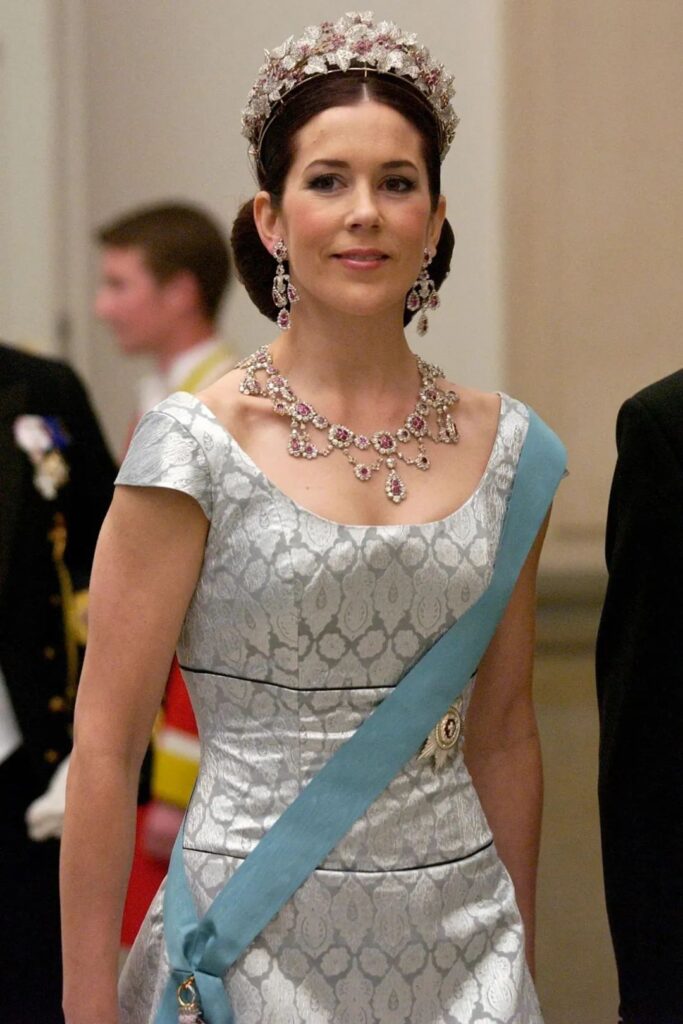
As the major brands have unveiled their latest high jewelry collections, it’s noteworthy that among all the publicly showcased pieces, only Chopard boasts two designs clearly labeled with “Pigeon’s Blood” rubies. Other brands have predominantly used Mozambique rubies, while the majority of red gemstones featured are actually Rubellite tourmalines and red spinels.
This trend clearly indicates that rubies, especially top-tier ones, are becoming increasingly scarce. Even luxury jewelry houses seem to be running low on stock, as creating a high jewelry piece requires not only a substantial quantity of rubies but also consistency in color tone – a challenge that’s becoming harder to meet.
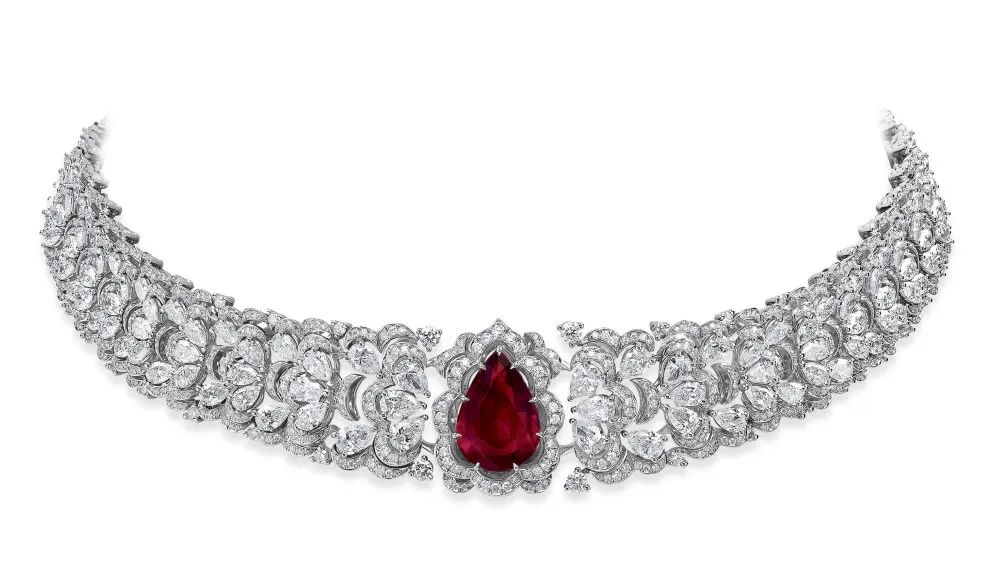
Red Carpet High Jewelry Collection Necklace
Set with a 7.01-carat “Pigeon’s Blood” ruby
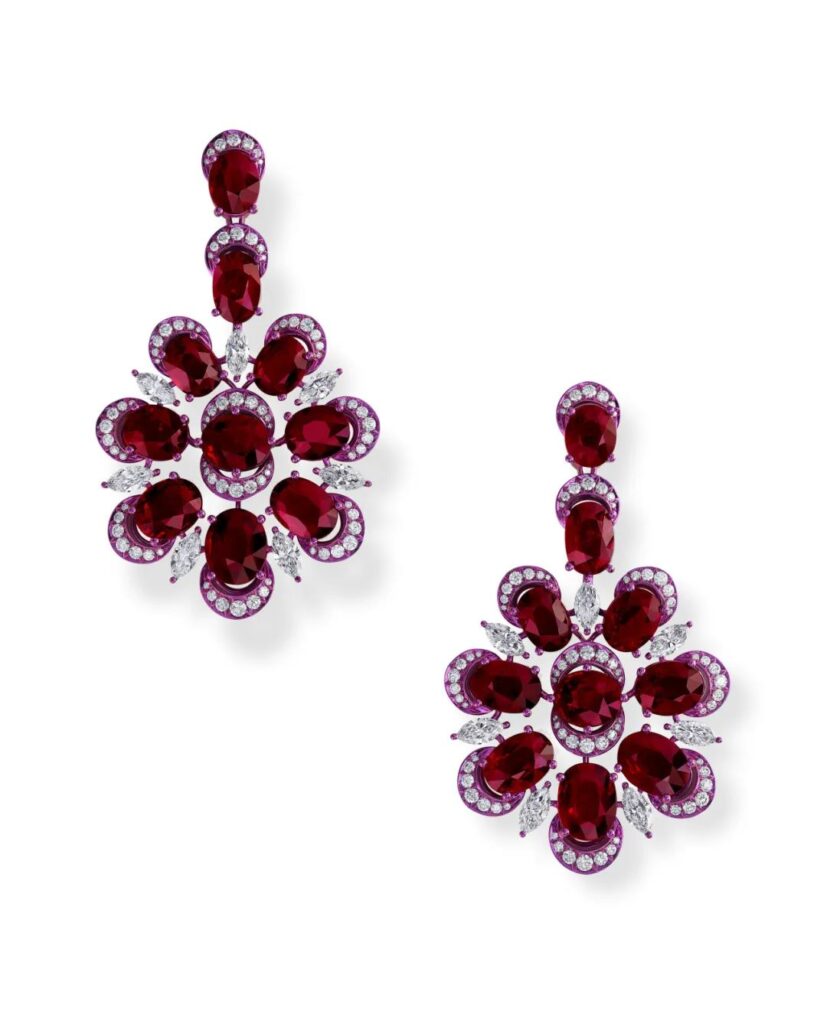
Red Carpet High Jewelry Collection Earrings
Set with “Pigeon’s Blood” rubies totaling 63.95 carats
In the market, from the Tucson show to the Hong Kong exhibition, ruby prices have been described by experts as “steadily rising.” Consequently, rubies have become highly sought-after by many collectors. This raises an important question: given the scarcity of rubies and their typically smaller carat sizes, how can jewelers maximize their impact to truly showcase the “King of Gems” in all its glory?
To address this, we must first understand why top-quality rubies are in such short supply. As many know, the most prestigious rubies are described as “Pigeon’s Blood,” which is a commercial term primarily denoting a color grade.
However, in the standards of some highly rigorous professional gemstone certification institutions, this designation not only requires meeting specific color criteria but also strictly specifies the place of origin. For instance, both the Swiss Gemmological Institute (SSEF) and Gübelin stipulate that only rubies originating from Myanmar (Burma) and meeting the color grading standards can be termed “Pigeon’s Blood.”
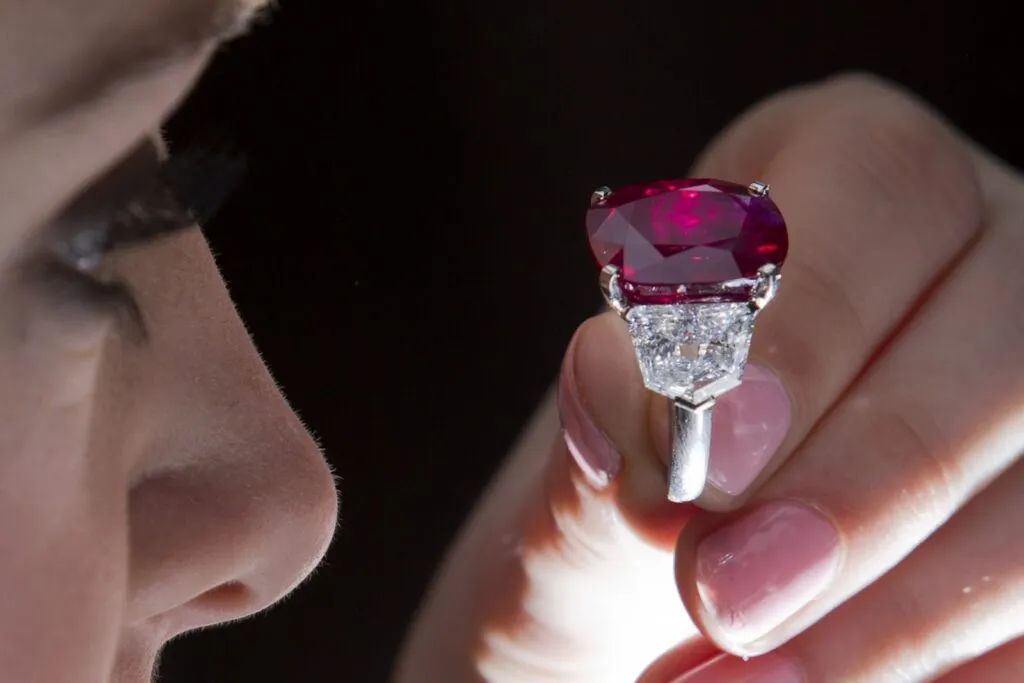
25.59-carat “Pigeon’s Blood” ruby
For collectors, what determines the value of a gemstone? Whether it’s color, clarity, or size, the fundamental factor is scarcity. This is why the origin of colored gemstones has such a significant impact on their value.
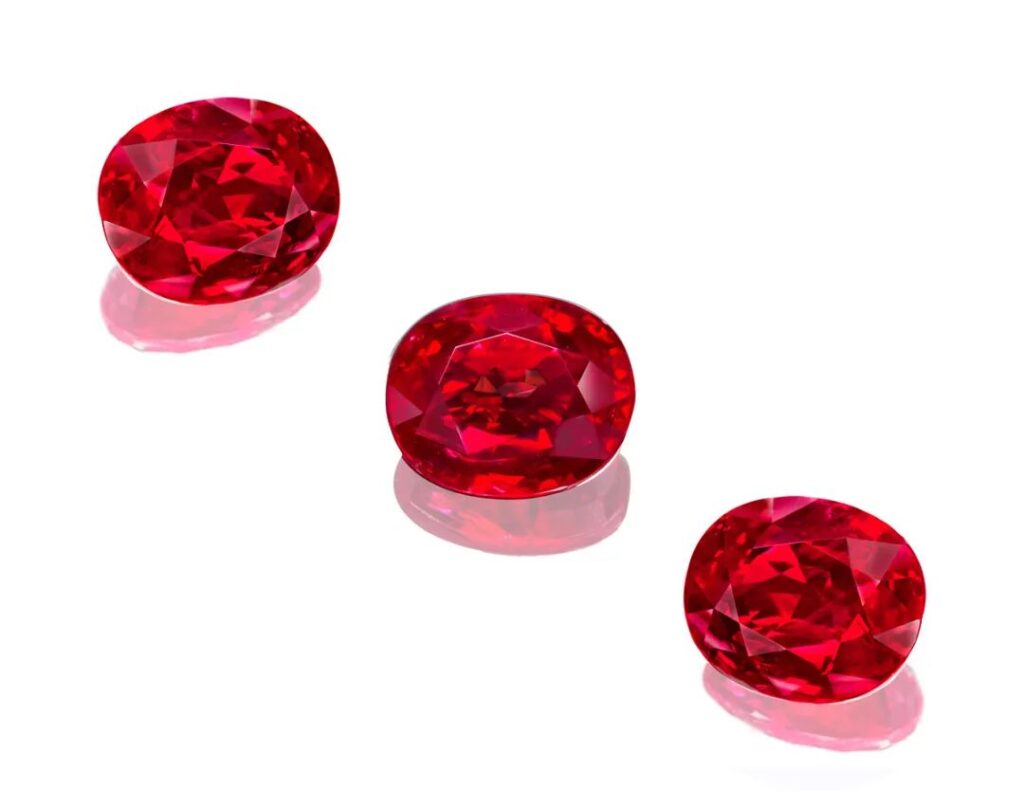
Despite Mozambique rubies often rivaling Burmese rubies in appearance and frequently occurring in larger carat sizes, they still can’t compete with Burmese rubies in terms of price. This ultimately comes down to the principle of rarity increasing value.
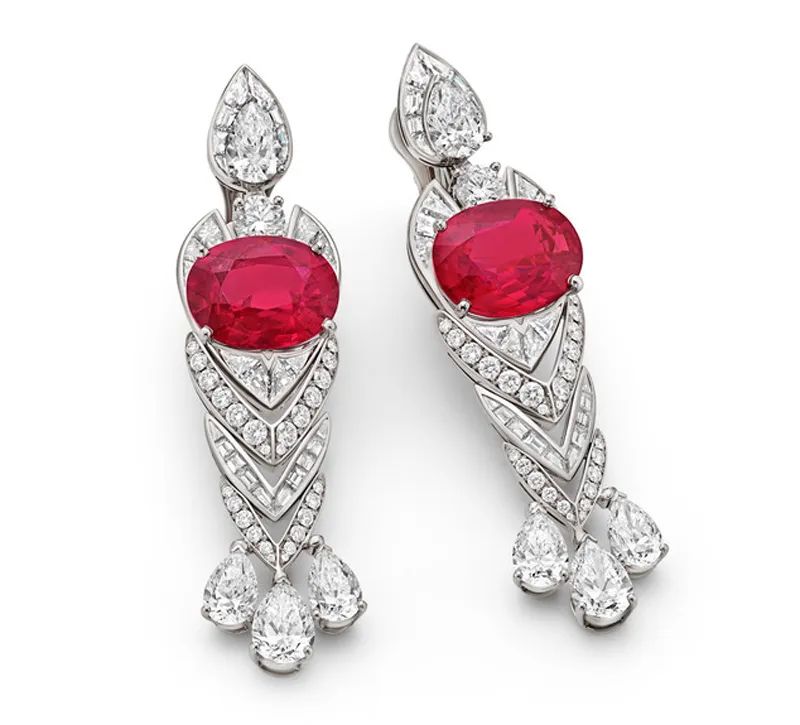
Aeterna High Jewelry Collection
Sequence of Eternity Earrings
2 Mozambique rubies
Weighing 8.92 carats and 8.06 carats respectively
Most Burmese rubies come from Mogok, an ancient gemstone mine that has been in operation since the 15th century. Large carat stones have long since been exhausted, and it’s now rare to find rubies over 5 carats. More importantly, frequent civil unrest in Myanmar has led to extremely unstable ruby production. The most recent conflict, which began in September 2023 and is still ongoing, is concentrated around Mogok, making mining operations nearly impossible.

(AFP Photo)
This has resulted in an extreme scarcity of Burmese rubies. They are currently very hard to find in the market, with the few that appear being from existing stock. The truly exceptional pieces have long since entered the auction houses. For ordinary collectors, unless they’re hoping to find an undervalued gem, they can only admire these stones from afar.
Therefore, instead of pursuing Burmese rubies, collectors might want to adjust their focus and consider the “Pigeon’s Blood” color grade alone. After origin, color is the most important factor for colored gemstones.
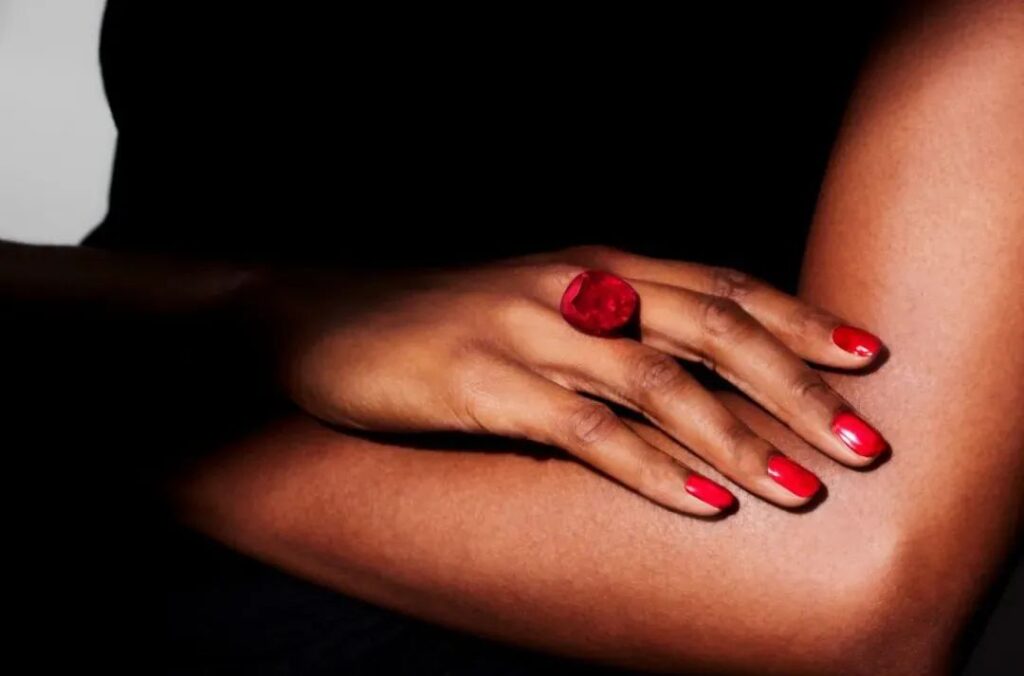
55.22-carat unheated Mozambique ruby
June 2023, Sotheby’s New York
Sold for $34,804,500
The “Pigeon’s Blood” red is pure, saturated, and bright, often with fluorescence. Unlike diamonds where fluorescence can decrease value, fluorescence in rubies can increase their value hundredfold. This is because it gives the impression of “burning fire” and “flowing blood,” creating a captivating effect. Gübelin even stipulates that a ruby must exhibit strong fluorescence under both long-wave and short-wave ultraviolet light to be classified as “Pigeon’s Blood.”
It is precisely because Burmese rubies have set such a high standard for exceptional rubies throughout history that collectors have come to revere their origin. However, due to the current scarcity, the jewelry world has had to settle for alternatives. By slightly lowering the demand for rarity and focusing purely on quality factors, Mozambique rubies have seized the opportunity to successfully “ascend” in status.
There’s a reason why rubies are called the “King of Gems.” Although they can’t compete with emeralds or sapphires in terms of carat size, their color is more eye-catching and captivating. A pure red color, reminiscent of burning fire, commands attention in any piece of jewelry. No one can resist the allure of this red hue, from royalty to the wealthy to celebrity icons – all desire to own a piece of ruby jewelry. But how can these small yet highly valuable gems be highlighted in jewelry designs?
Royalty Uses Tiaras to Showcase the “Supreme” Status of Rubies
European royals traditionally set rubies in tiaras – indeed, placing them high naturally makes them more noticeable. However, apart from Queen Elizabeth II’s Burmese Ruby Tiara, which lavishly uses rubies in large Tudor rose clusters, other royal collections don’t have many rubies and tend to take a more “clever” approach.

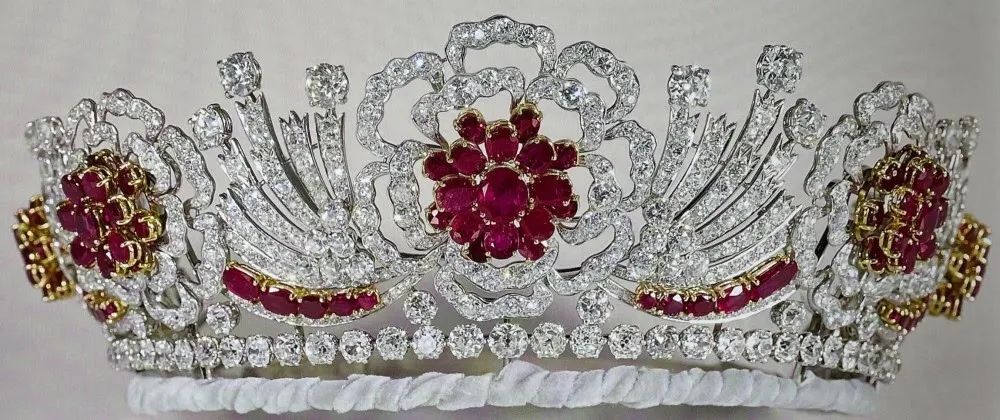
One of the most famous “representative works” is the Danish Ruby Parure Tiara. This tiara features lifelike flowers and leaves made of diamonds and gold. Small carat but vibrantly colored rubies are used as berries dotted among the flowers and leaves. This design not only creates a natural and complete composition, but the small touches of red also stand out brilliantly against the colorless gold and silver backdrop.

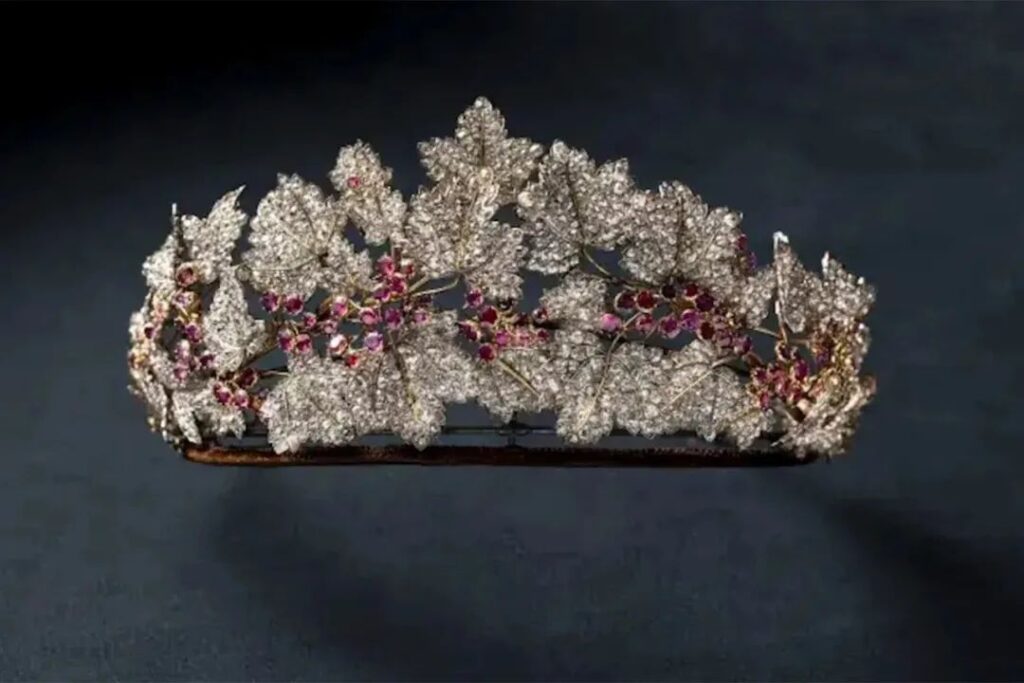
For scenarios with larger carats but fewer stones, there’s the ruby tiara commissioned by Isabella, Duchess of Württemberg, from the Austrian court jeweler Köchert. It uses only 7 Burmese rubies, with three larger ones set in detachable bow-shaped hair clips. This design frames the rubies with elegant and glamorous diamond borders, making the rubies truly stand out.
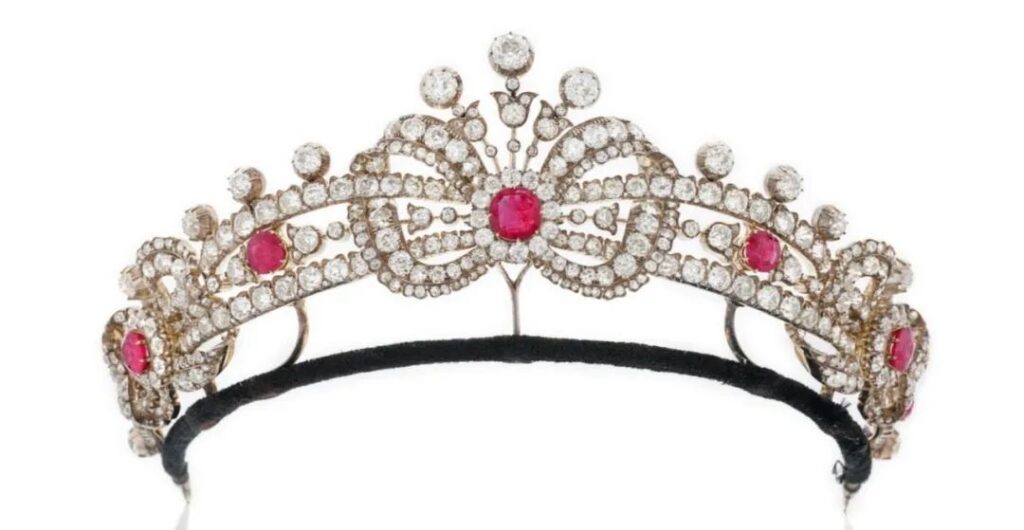
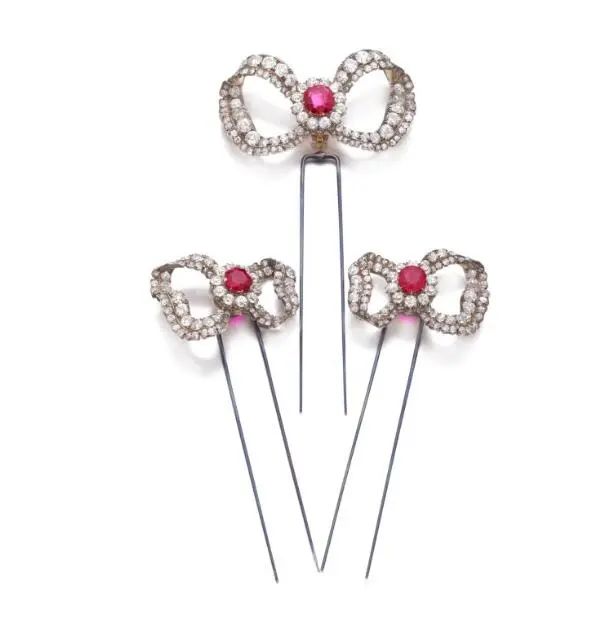
Due to the scarcity of rubies, tiaras from this era were often designed to be convertible. For instance, this early 20th-century ruby tiara, set with 26 Burmese “Pigeon’s Blood” rubies ranging from 1.02 to 1.70 carats, can be transformed into a necklace by removing the frame. The orderly, geometric arrangement of the rubies effectively highlights them, suitable for designs with numerous smaller carat stones.
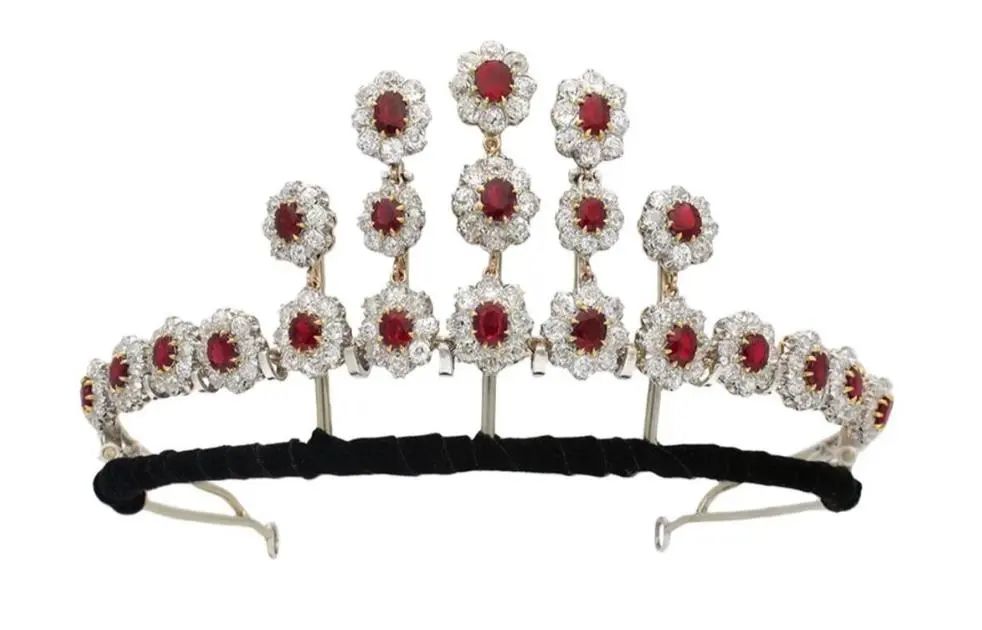
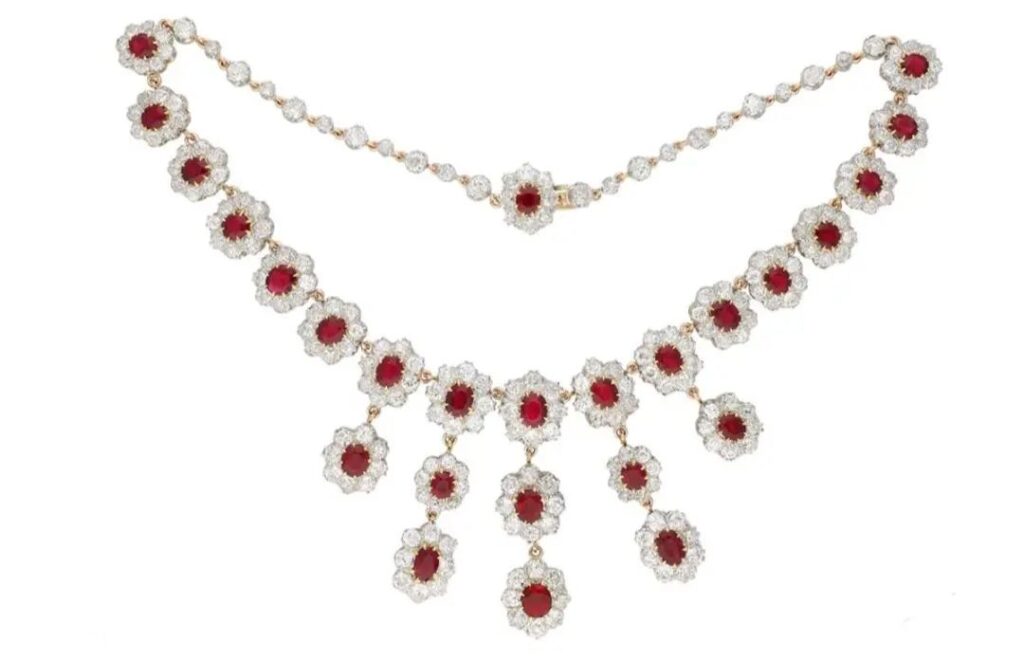
Modern Jewelry Masters’ Ruby Masterpieces
In modern times, while tiaras have fewer occasions for use, exceptional rubies have become the absolute stars of high jewelry. No matter how scarce, they must make an appearance each high jewelry season! This demonstrates the confidence of major jewelry brands. Despite the current tight supply of Burmese rubies, this year’s high jewelry season still saw noteworthy ruby masterpieces.
In Chaumet’s “Chaumet en Scène” high jewelry collection, an “Illusion” themed necklace features Mozambique rubies totaling 15.63 carats. Instead of focusing solely on the rubies, the brand ingeniously designed the diamond chain. Three strands of three-dimensional diamond chains create a twisted illusion, cleverly drawing the eye to five vertically aligned rubies at the center, naturally making them the highlight of the entire piece.
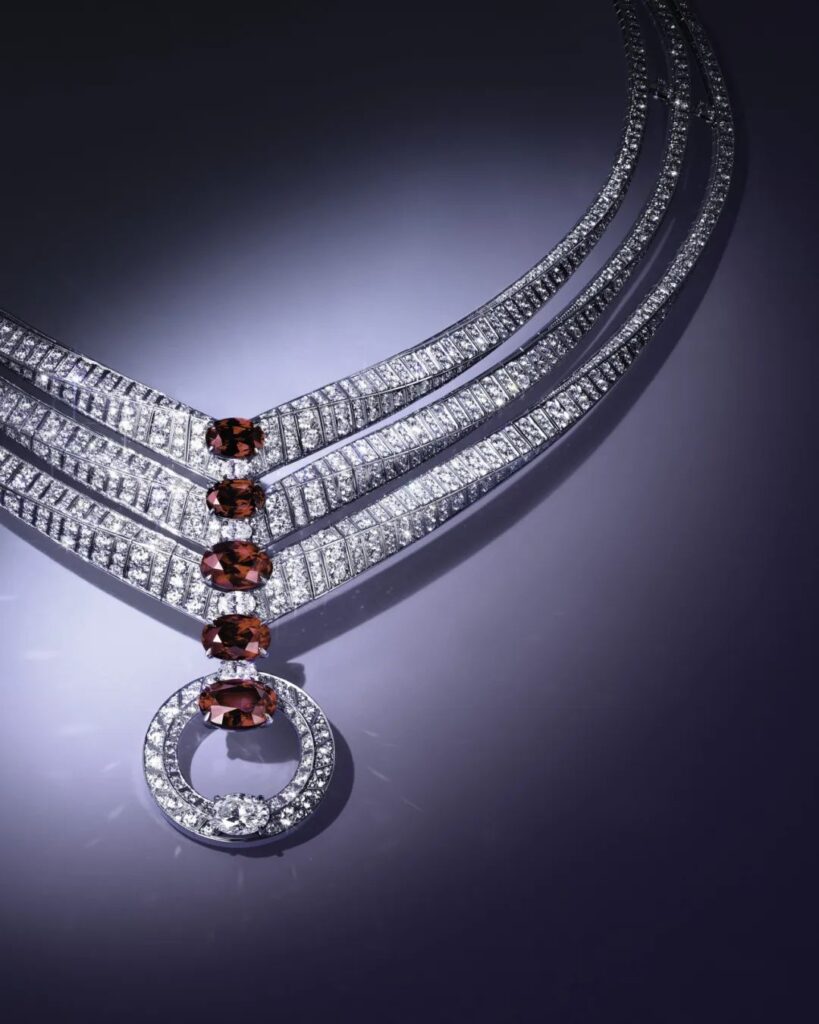
Chaumet en Scène High Jewelry Collection
Illusion Themed Necklace
Pomellato’s “Pink Rubellites” necklace adopts the brand’s classic Princess necklace style but features a 17.07-carat ruby as the centerpiece. Creative Director Vincenzo Castaldo, still considering this ruby insufficient in size, surrounded it with 484 red spinels.
This visually enhances the ruby’s size and depth, while two pavé spinel chain links extend the vibrant red upwards, immediately conveying the ruby’s overwhelming presence and powerfully embodying the concept of “dominating presence.”
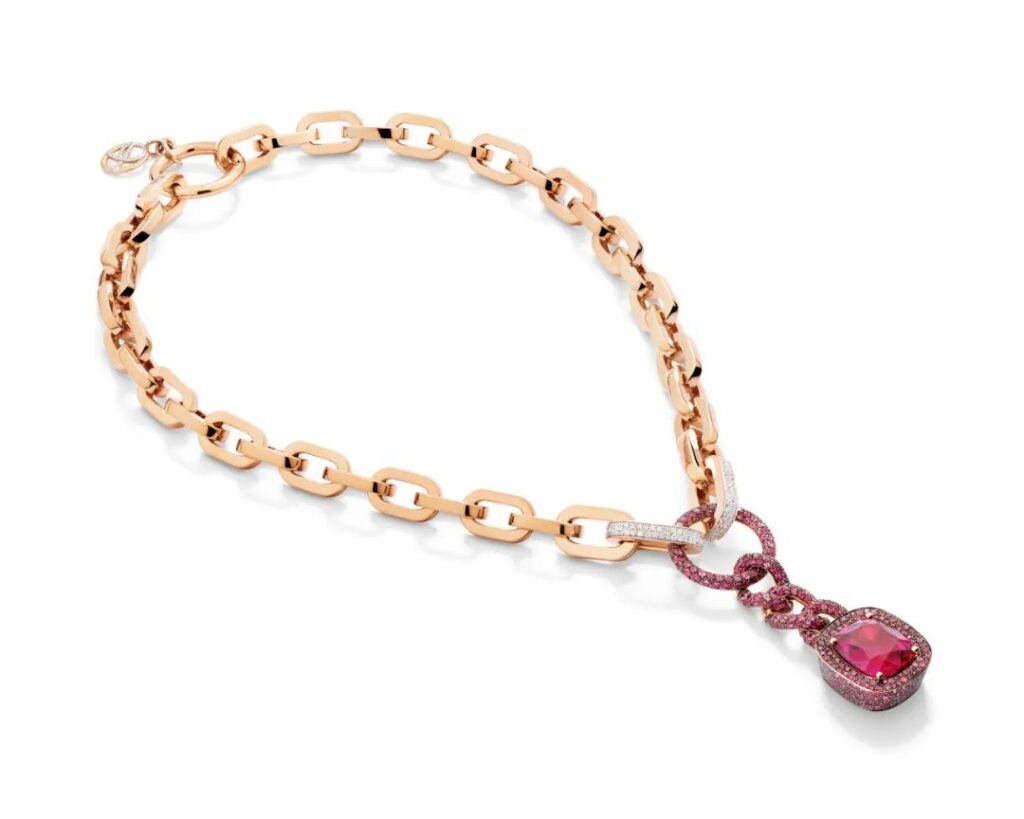
The Dualism of Milan High Jewelry Collection
Pink Rubellites Necklace
Louis Vuitton is this season’s most lavish user of rubies. In their “Awakened Hands, Awakened Minds” high jewelry collection, they selected over 110 rubies with perfectly matched saturation, color, and hue, all used in the Splendeur theme suite. The choker alone is set with 52 rubies, making it Louis Vuitton’s single jewelry piece with the most rubies to date.
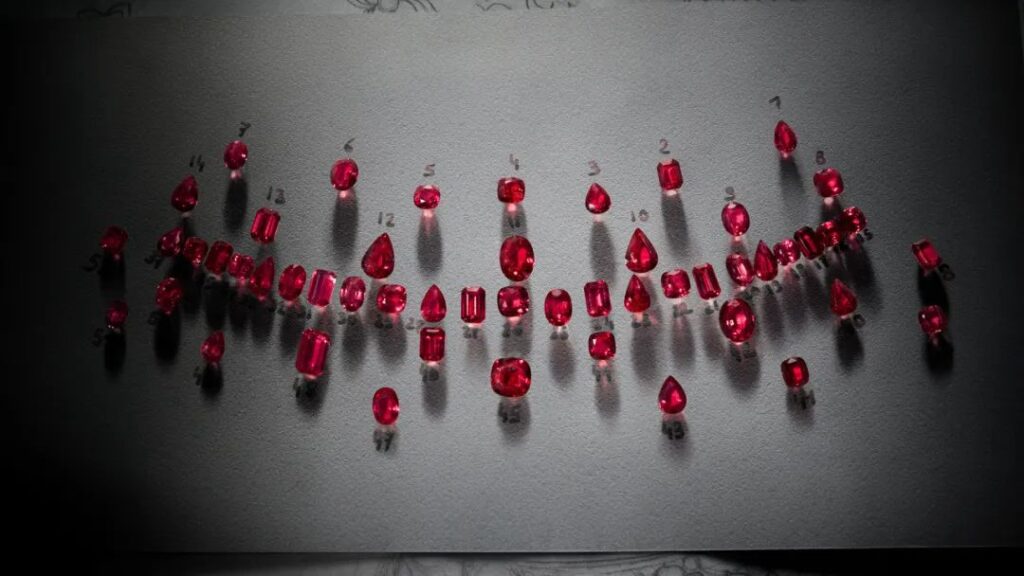
Awakened Hands, Awakened Minds High Jewelry Collection
Rubies used in the Splendeur theme suite
As the name suggests, this piece exudes courtly opulence, inspired by French court woodcarving techniques. Creative Director Francesca Amfitheatrof used gold to carve floral reliefs, creating 2,400 individual components for this three-dimensional choker. It’s one of Louis Vuitton’s most complex pieces this season, requiring 3,217 hours of work by 17 stone setters and 30 jewelers to complete this masterpiece.
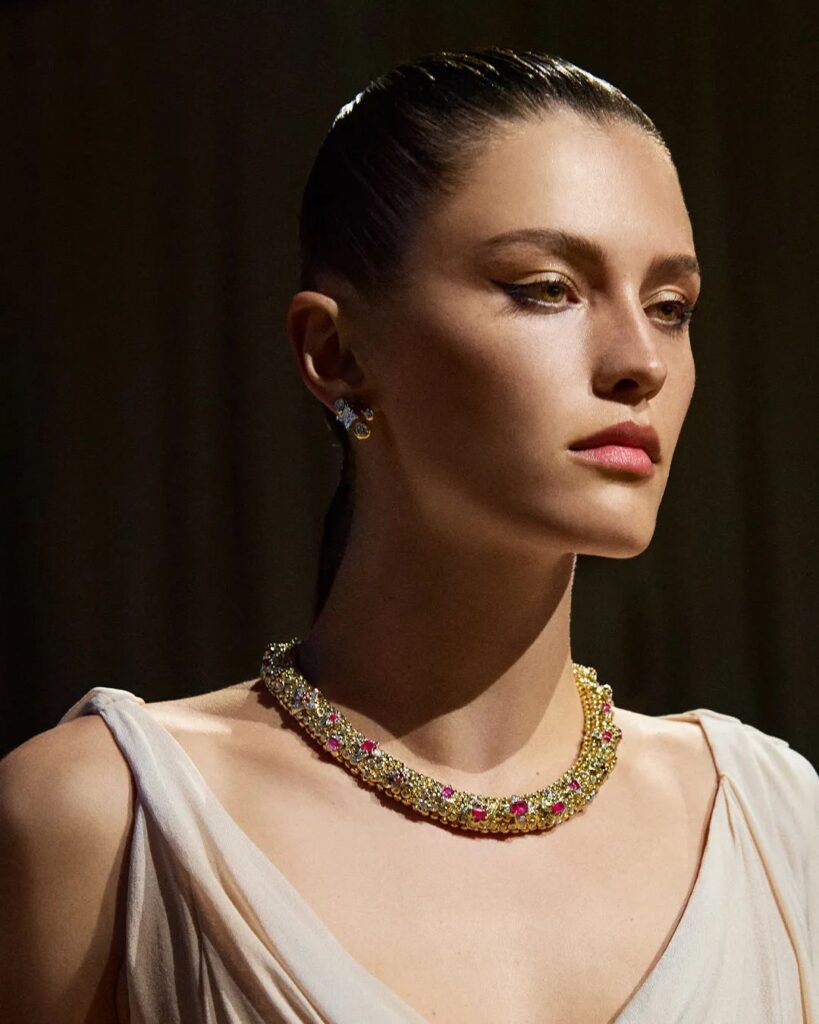
Awakened Hands, Awakened Minds High Jewelry Collection
Splendeur Theme Necklace
Chopard’s Red Carpet high jewelry collection this year presented several ruby pieces, including some “outrageously luxurious” designs. One features a 7.01-carat “Pigeon’s Blood” ruby set in the center of an all-diamond choker, while another boasts earrings with 63.95 carats of “Pigeon’s Blood” rubies, both dazzlingly red.
However, a ruby ring best embodies the collection’s “fairy tale story” theme, with rubies forming a rose from “The Little Prince,” complemented by black diamond leaves.
The most creative use of rubies in this season’s high jewelry actually comes from Chanel. They launched a Sport series, connecting seemingly unrelated sports with high jewelry. Patrice Leguéreau, Director of the Chanel Fine Jewelry Creation Studio, explains, “This is our biggest difference from traditional high jewelry brands; people don’t come to Chanel to buy a classic jewelry design.”

Sport High Jewelry Collection
Graphic Line Necklace
White gold, platinum, diamonds, sapphires, rubies, onyx
Indeed, creativity is the hallmark of Chanel’s high jewelry. In their new works, they use very bold and vivid colors to convey concepts of sports, speed, and energy. We can see clear stripe patterns formed by rubies on pavé diamonds, with carefully designed arrangement order and angles allowing the rubies to outline dazzling lines.
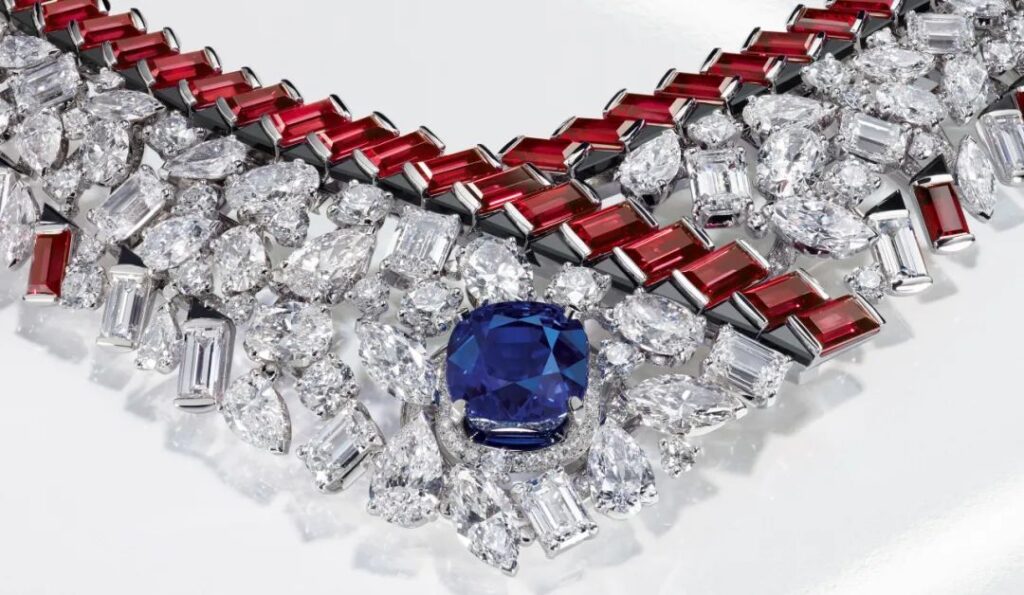
This approach doesn’t rely on the quantity or size of rubies but cleverly uses contrast to make rubies play a pivotal role, becoming the most eye-catching element in the jewelry. It demonstrates how, even with limited resources, rubies can be used to maximum effect, truly showcasing the “King of Gems” in all its glory.
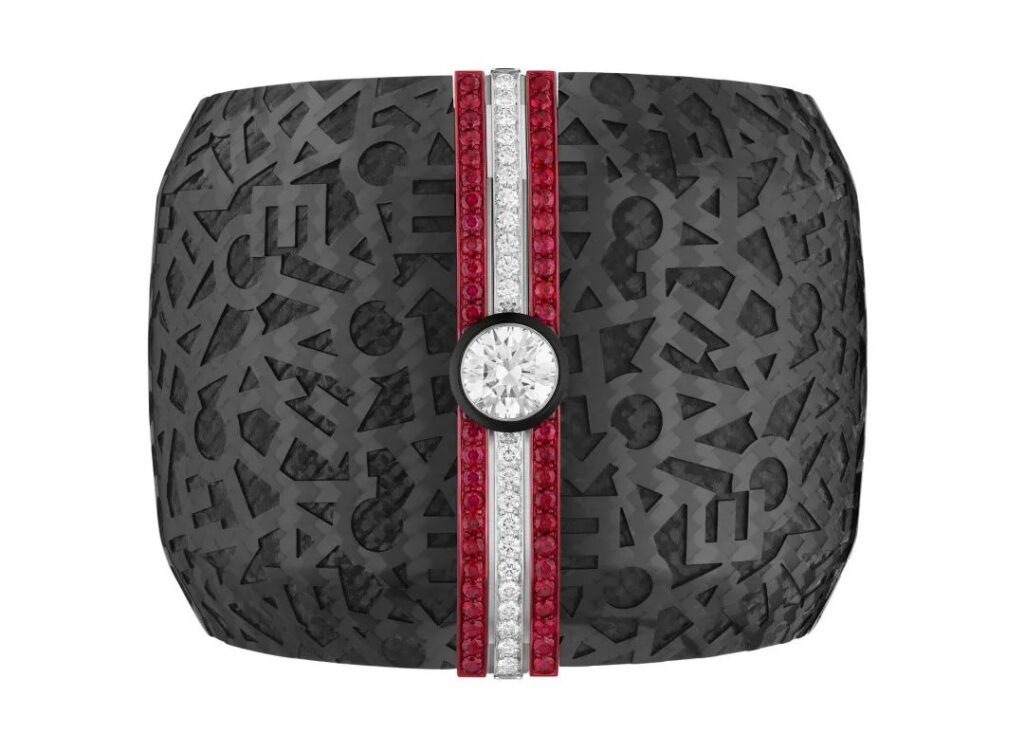
Sport High Jewelry Collection
Print Cuff Bracelet
White gold, diamonds, rubies, carbon, black lacquer, red aluminum
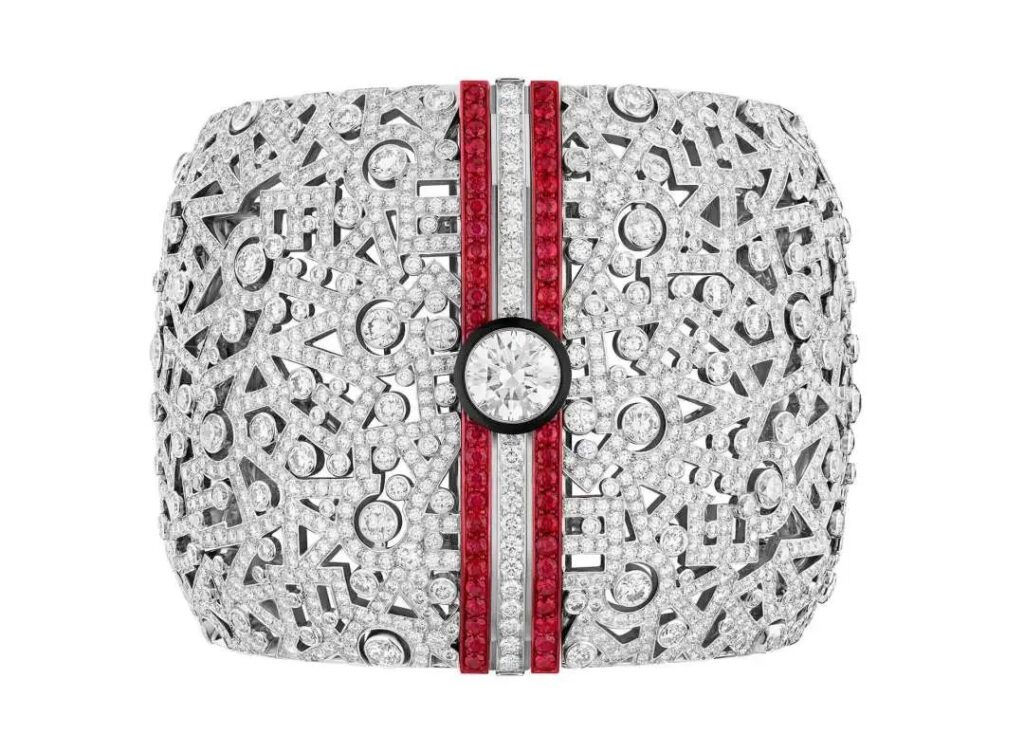
Sport High Jewelry Collection
Print Cuff Bracelet
White gold, diamonds, rubies, carbon, black lacquer, red aluminum
Now that you’ve learned how to maximize the “rarity” of rubies, let’s explore where to find these scarce gems. Indeed, some affluent collectors still possess “reserves” of top-quality rubies.
Jewelry brand Faidee, founded by gem merchant Roop Chand Lunia in 1905, has a deep passion for Burmese rubies.
Now in its fourth generation, it’s the world’s only brand specializing in Burmese ruby jewelry. Current Design Director Ravi Lunia says, “The challenge lies in assembling rubies of the same hue and quality for a single piece of jewelry.” They’re incredibly patient; for instance, their signature Grand Phoenix necklace uses Burmese rubies collected over four generations, spanning 100 years.
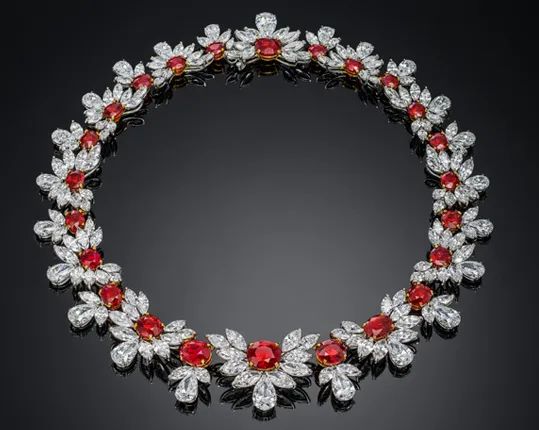
Their large pieces often appear at auctions, always attracting collectors’ attention. However, due to the quantity required for high jewelry and strict quality control, producing one piece a year is considered good. Ravi Lunia explains, “For rubies, especially Burmese rubies, carat weight greatly impacts their value.
In recent years, exceptional stones over 3 carats have become rare, making it extremely difficult to gather enough for even a bracelet.”
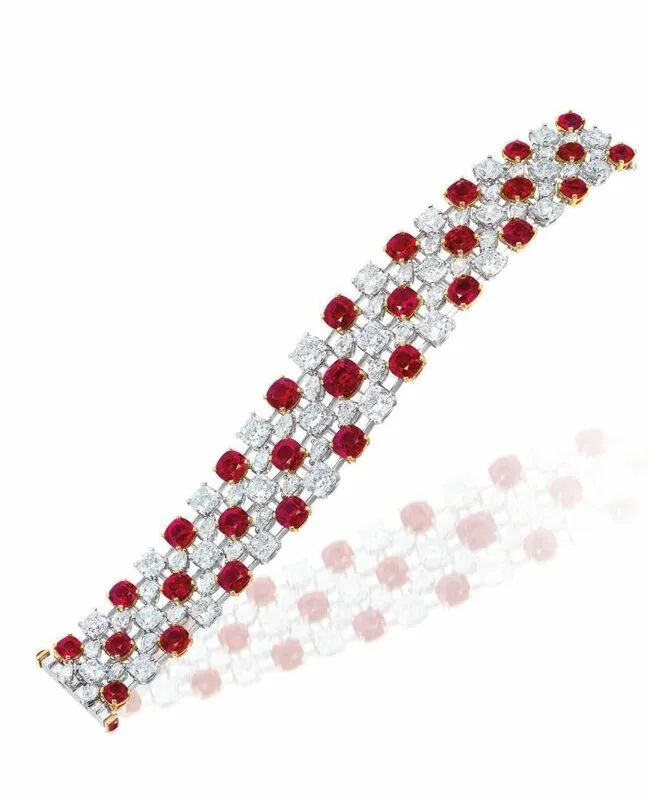
29 Burmese Pigeon’s Blood rubies (1.02-4.22 carats)
Christie’s Hong Kong, May 2016
Sold for HKD 27,000,000
Faidee also designs smaller pieces, ensuring every ruby used is unheated and from Burma. If you’re truly seeking top-tier Burmese rubies, this brand is worth considering.
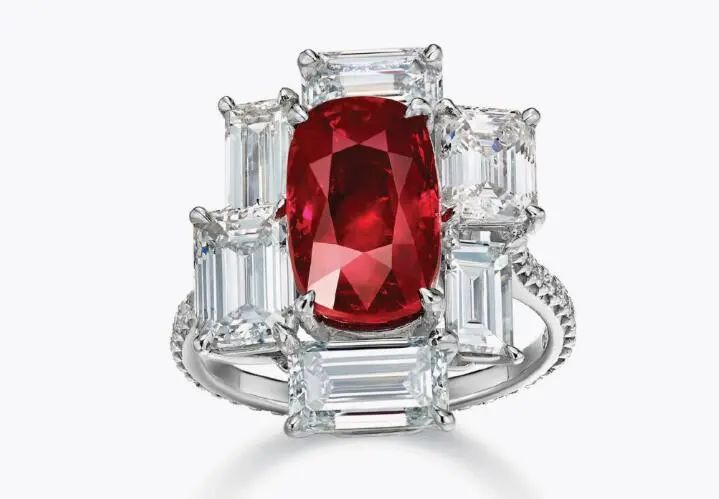
Set with a 4.05-carat Burmese Pigeon’s Blood ruby
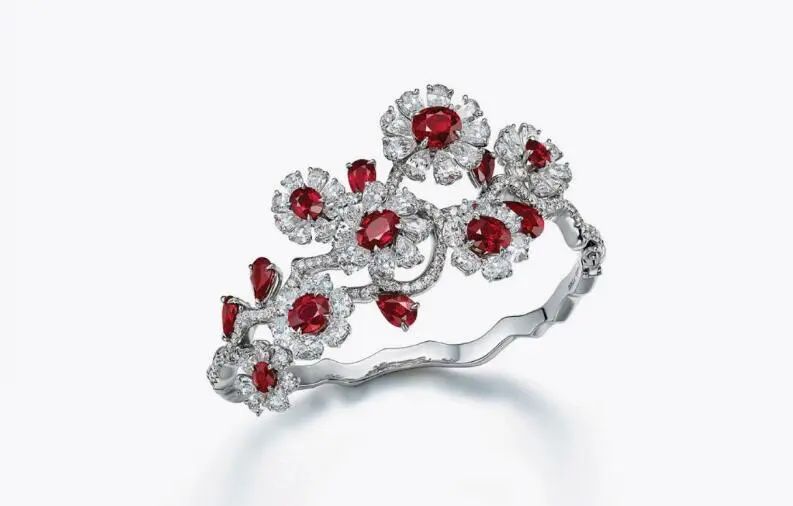
Set with Burmese Pigeon’s Blood rubies totaling 9.95 carats
Haruni Fine Gems is another family-owned jewelry brand, now in its third generation, specializing in rare gemstone custom designs, focusing on sapphires and rubies. The family originally from Persia, moved to India, and finally to England.
Current Creative Director Richard Haruni says, “My father and uncle focused on being gem merchants, supplying stones to major jewelry brands like Van Cleef & Arpels and David Morris in the 1960s, until we established our jewelry company in London.”
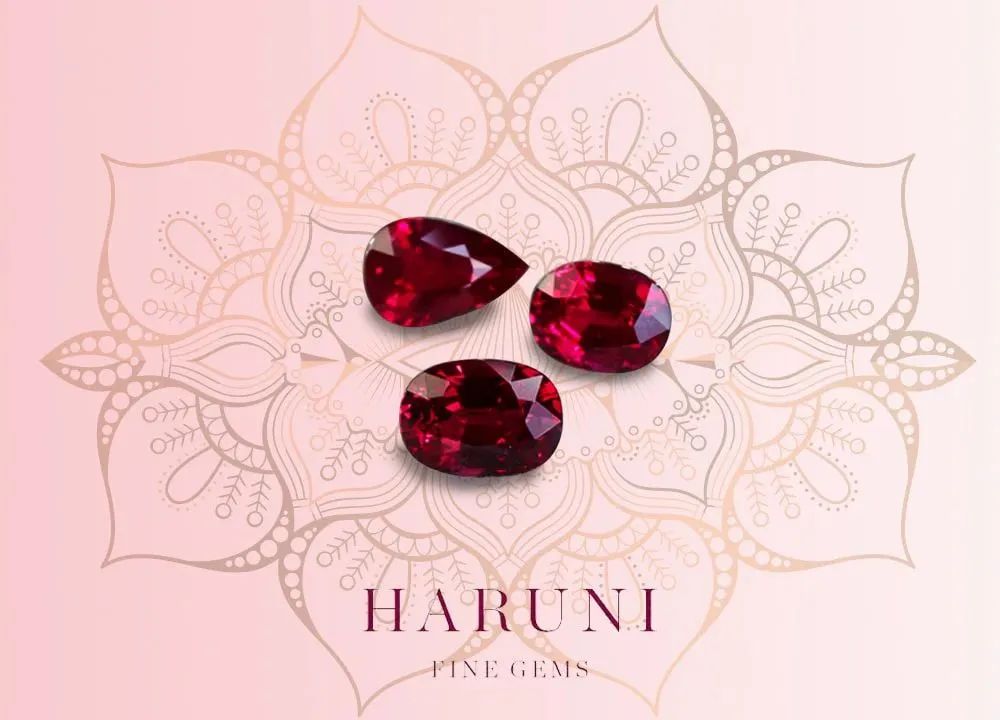
Ronald Abram, headquartered in Hong Kong, also has roots in gem trading. While not specializing in rubies, they prefer only top-tier gemstones, so they possess some exceptional Burmese rubies. Founder Ronald Abram moved from New York to Hong Kong after discovering Asians’ love for colored gemstones, opening a jewelry salon at the Mandarin Oriental Hotel.
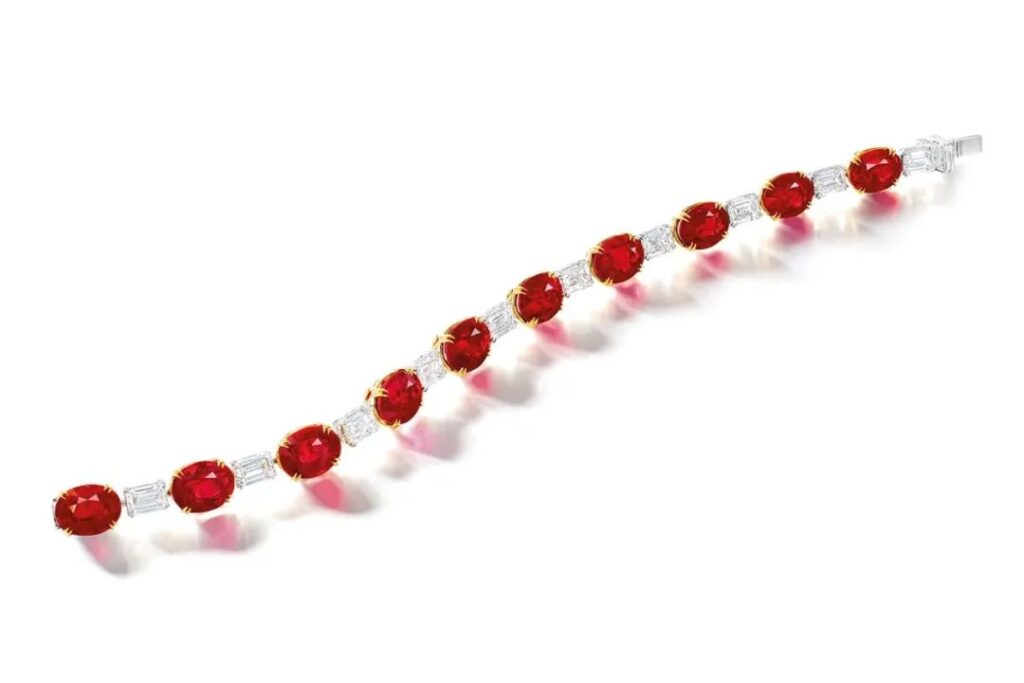
He once said in an interview, “Our business is small but focuses on ‘pure design’. There are basically two ways to make jewelry: either create a concept and then find stones for it, or create a concept around the stones. Given our background as gem dealers, we choose the latter.”
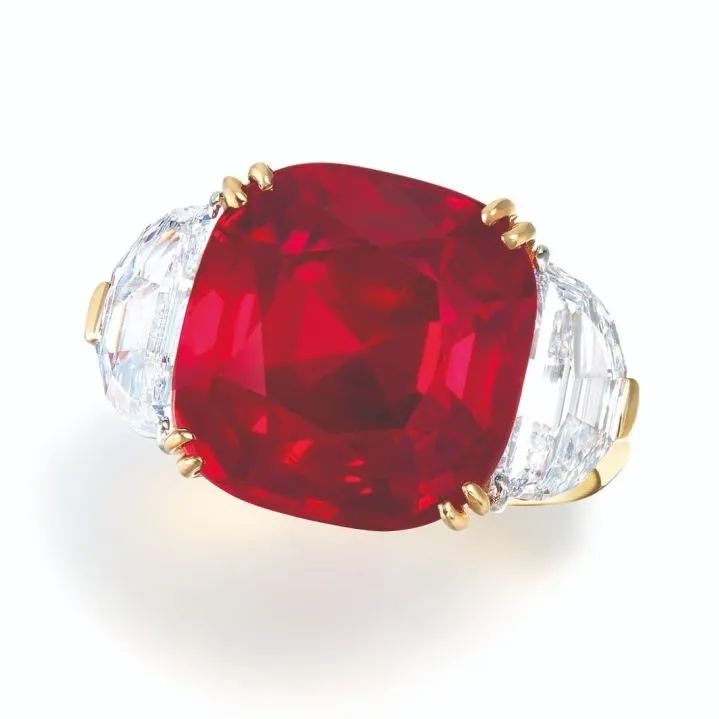
Besides these small jewelry brands with gem merchant family backgrounds, Gübelin Jewellery, associated with the gemological institute, also has “stock” of exceptional Burmese rubies. Jewelry enthusiasts are familiar with Gübelin as a Swiss professional gemstone certification institution. However, it’s actually a family business dating back to 1854, originally a watchmaking workshop.
In the 1920s, the Gübelin family opened their own jewelry workshop and established a small gemstone laboratory to test jewelers’ stones and ensure their authenticity. Eduard Josef Gübelin, a renowned gemologist with a passion for gemstone inclusions, built the company’s reputation in gemstone certification, making Gübelin an authority in gemstone origin determination.
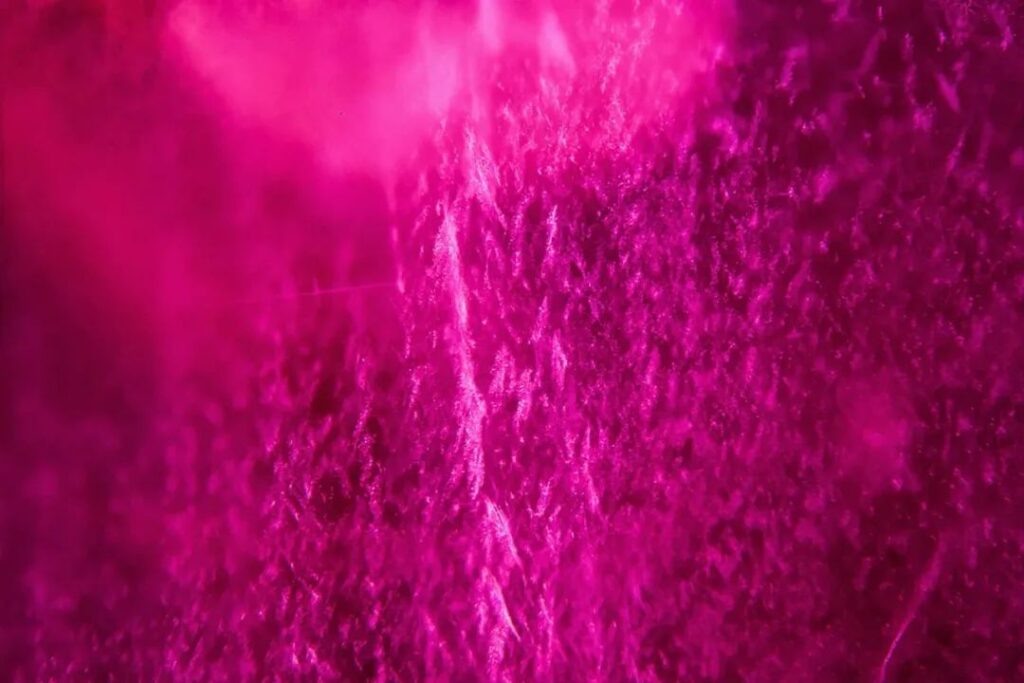
Their jewelry designers drew inspiration from the iconic rutile needle inclusions in Burmese rubies to create the “Red Dahlia” ring, using colored sapphires to depict the rutile needles surrounding a 2.18-carat Burmese “Pigeon’s Blood” ruby.
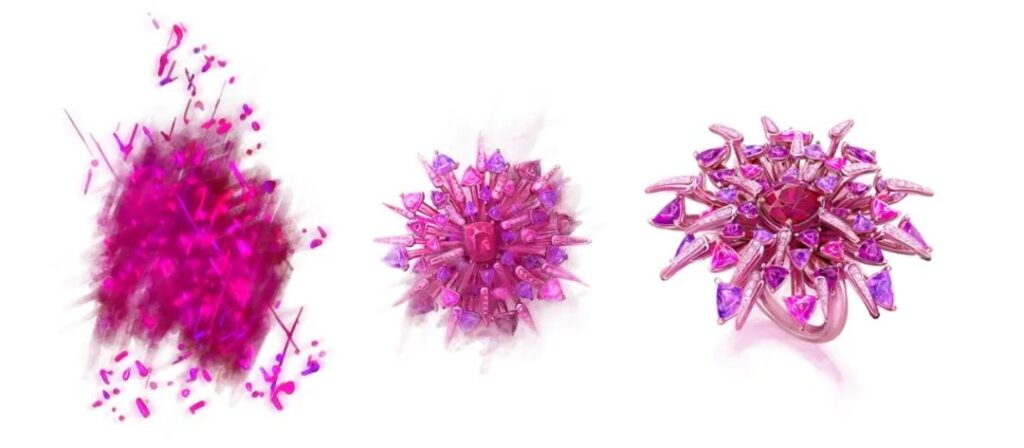
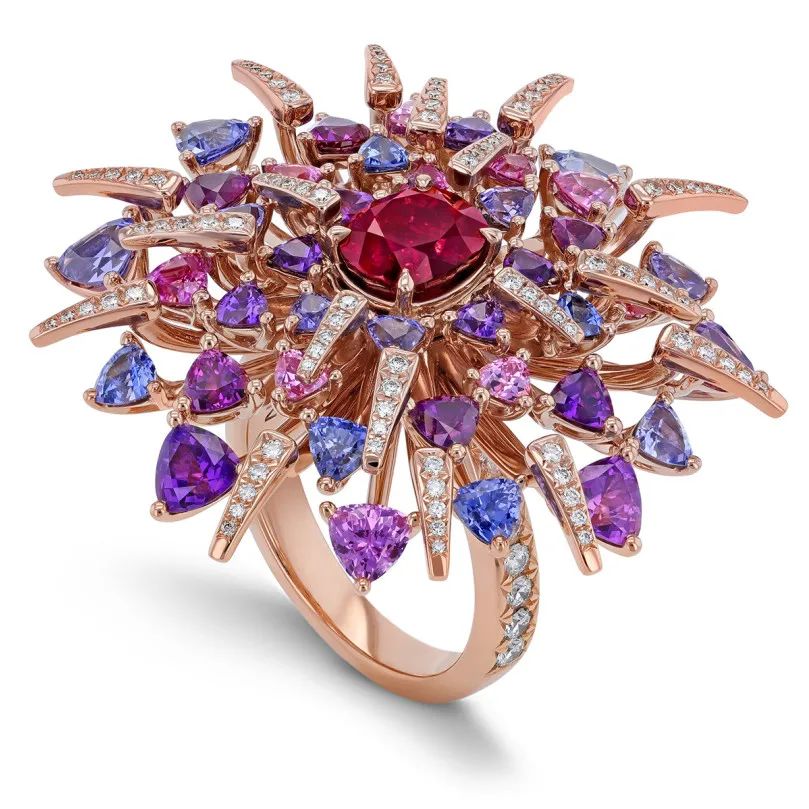
This gemologist was also a gem collector, amassing various rare stones, with rubies being his favorite. He said, “Almost no other gemstone evokes such strong emotional resonance as the ruby. Since ancient times, in most people’s eyes, rubies have symbolized the world’s highest wealth – love. For children born in July, rubies represent their longed-for freedom, kindness, respect, and dignity.”
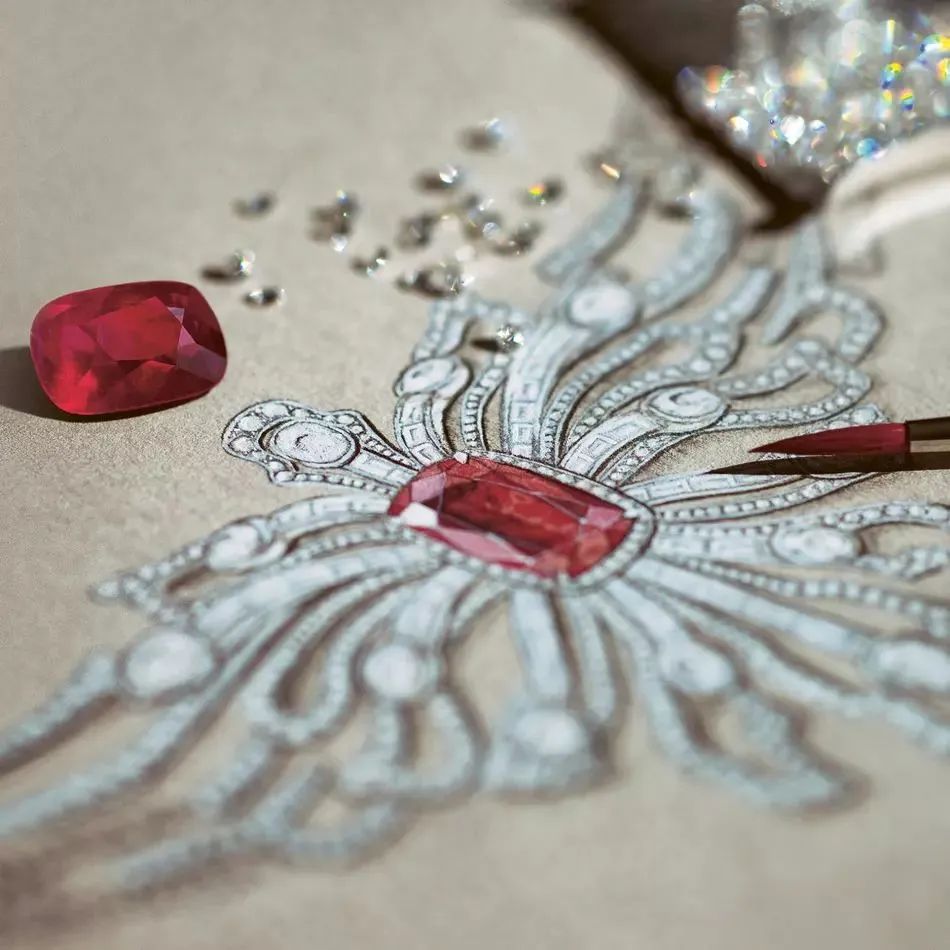
This is why Gübelin uses rubies as their brand signature, naturally favoring high-quality rubies in their jewelry designs. With the backing of a top-tier gemstone certification institution, they likely have some “stock” of Burmese rubies.
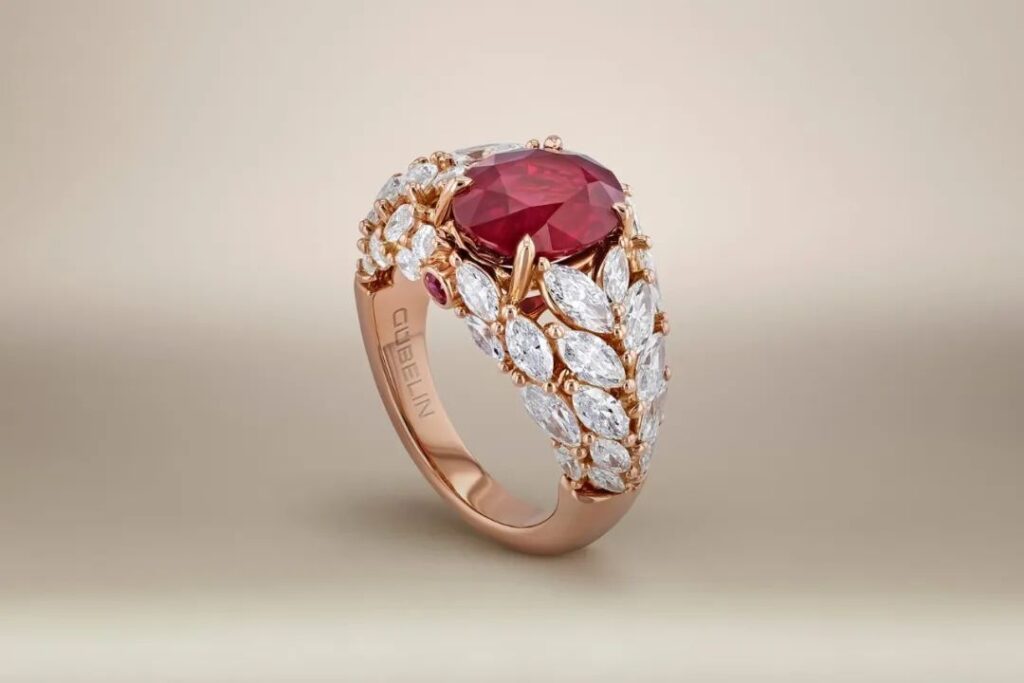
Burmese “Pigeon’s Blood” Ruby Ring
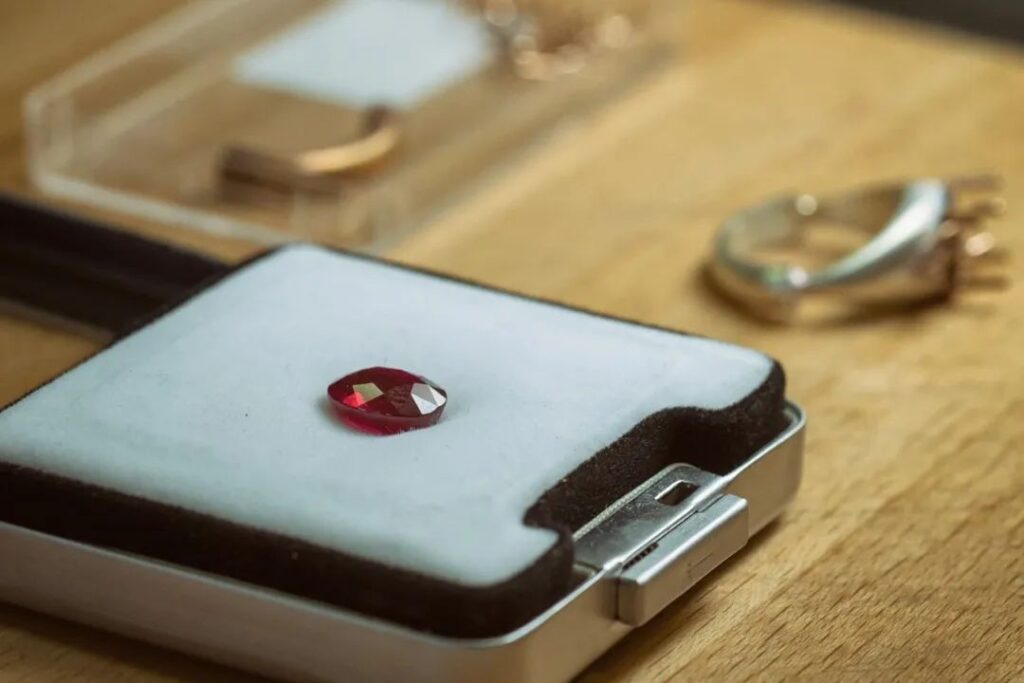
Burmese “Pigeon’s Blood” Ruby
Other possible sources for exceptional rubies include antique jewelry stores and auction houses, as rubies have repeatedly broken auction records and are frequent stars at auctions. Here’s hoping everyone can find their desired July birthstone and successfully showcase its “regal presence.”
Unleashing the King of Gems: How to Maximize Ruby’s Regal Presence in an Era of Scarcity
Tweet





